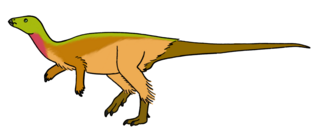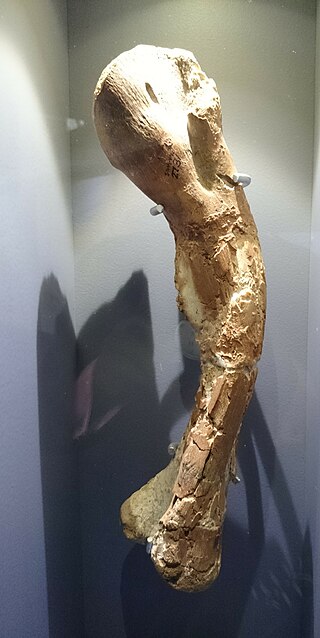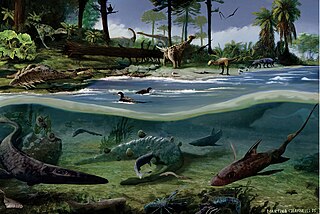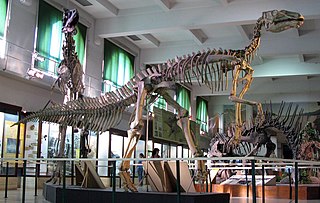
James Ross Island is a large island off the southeast side and near the northeastern extremity of the Antarctic Peninsula, from which it is separated by Prince Gustav Channel. Rising to 1,630 metres (5,350 ft), it is irregularly shaped and extends 64 km in a north–south direction. It was charted in October 1903 by the Swedish Antarctic Expedition under Otto Nordenskiöld, who named it for Sir James Clark Ross, the leader of a British expedition to this area in 1842 that discovered and roughly charted a number of points along the eastern side of the island. The style, "James" Ross Island is used to avoid confusion with the more widely known Ross Island in McMurdo Sound.

Qantassaurus is a genus of basal two-legged, plant-eating elasmarian ornithischian dinosaur that lived in Australia about 125-112 million years ago, when the continent was still partly south of the Antarctic Circle. It was described by Patricia Vickers-Rich and her husband Tom Rich in 1999 after a find near Inverloch, and named after Qantas, the Australian airline.

Notohypsilophodon is a genus of ornithopod dinosaur from the Late Cretaceous of Argentina. It was described as the only "hypsilophodont" known from South America, although this assessment is not universally supported, and Gasparinisaura is now believed to have been a basal euornithopod as well.

Anabisetia is a genus of ornithopod dinosaur from the Late Cretaceous Period of Patagonia, South America. It was a small bipedal herbivore, around 2 metres long.

Fulgurotherium is a dubious genus of ornithischian dinosaur from the Late Cretaceous (Cenomanian) Griman Creek Formation. It lived in what is now Australia.

Talenkauen is a genus of basal iguanodont dinosaur from the Campanian or Maastrichtian age of the Late Cretaceous Cerro Fortaleza Formation, formerly known as the Pari Aike Formation of Patagonian Lake Viedma, in the Austral Basin of Santa Cruz, Argentina. It is based on MPM-10001A, a partial articulated skeleton missing the rear part of the skull, the tail, and the hands. The type and only species is Talenkauen santacrucensis.

Kangnasaurus is a genus of iguanodontian ornithopod dinosaur found in supposedly Early Cretaceous rocks of South Africa. It is known from a tooth and possibly some postcranial remains found in the early-Aptian Kalahari Deposits Formation. It was probably similar to Dryosaurus.

Gasparinisaura is a genus of herbivorous ornithopod dinosaur from the Late Cretaceous.

Jeholosaurus is a genus of neornithischian dinosaur from the Early Cretaceous Period. It is thought to have been a herbivorous small ornithopod.

Antarctopelta is a genus of ankylosaurian dinosaur, a group of large, quadrupedal herbivores, that lived during the Campanian stage of the Late Cretaceous period on what is now James Ross Island, Antarctica. Antarctopelta is the only known ankylosaur from Antarctica and a member of Parankylosauria. The only described specimen was found in 1986, the first dinosaur to be found on the continent, by Argentine geologists Eduardo Olivero and Robert Scasso. The fossils were later described in 2006 by paleontologists Leonardo Salgado and Zulma Gasparini, who named the type species A. oliveroi after Olivero.

Macrogryphosaurus is a genus of elasmarian dinosaur from the Coniacian age Upper Cretaceous Sierra Barrosa Formation of Argentina in Patagonia. It was described by Jorge Calvo and colleagues in 2007, with M. gondwanicus as the type and only species.

The Snow Hill Island Formation is an Early Maastrichtian geologic formation found on James Ross Island, James Ross Island group, Antarctica. Remains of a paravian theropod Imperobator antarcticus have been recovered from it, as well as the elasmarian ornithopods Trinisaura santamartaensis, Biscoveosaurus and Morrosaurus antarcticus, the ankylosaurian Antarctopelta oliveroi, and the shark Notidanodon sp. Alongside these described genera are also the remains of indeterminate elasmosaurids, lithostrotian titanosaurs and an indeterminate pterosaur.

Elasmaria is a clade of ornithopods known from Cretaceous deposits in South America, Antarctica, and Australia that contains many bipedal ornithopods that were previously considered "hypsilophodonts".

Trinisaura is a genus of ornithopod dinosaur that lived during the late Campanian stage of the Upper Cretaceous, around 73 to 72 million years ago in what is now James Ross Island off the coast of northern Antarctica near Patagonia. It is known from a single, incomplete postcranial skeleton that includes several vertebrae, a partial pelvis, and nearly complete right hindlimb. The fossils were collected in 2008 by paleontologists Juan Moly and Rodolfo Coria from the sandstone of the Snow Hill Island Formation. It remained undescribed in the collections of the Museo de La Plata until its description by Coria and colleagues in 2013, being the basis of the novel genus and species Trinisaura santamartaensis. The genus name is to commemorate the efforts of Argentine geologist Trinidad "Trini" Diaz and the Latin root -sauros, meaning "lizard". The species name is after Santa Marta Cove, where the fossils were collected.
Sektensaurus is a genus of ornithopod dinosaur, possibly an elasmarian, from the Late Cretaceous (Campanian) of Patagonia, Argentina. Its remains were uncovered in the fluvial tuffs of the Lago Colhué Huapí Formation in the Golfo San Jorge Basin. The type and only species is S. sanjuanboscoi.

Huallasaurus is an extinct genus of saurolophine hadrosaur from the Late Cretaceous Los Alamitos Formation of Patagonia in Argentina. The type and only species is H. australis. Originally named as a species of Kritosaurus in 1984, it was long considered a synonym of Secernosaurus before being recognized as its own distinct genus in a 2022 study, different from other members of Kritosaurini.

Kelumapusaura is a genus of saurolophine hadrosaur from the Late Cretaceous Allen Formation in what is now Patagonia in Argentina. The type and only species is K. machi, known from a bonebed of various individuals.
Patagopelta is an extinct genus of nodosaurine dinosaur from the Late Cretaceous Allen Formation of Argentina. The genus contains a single species, P. cristata, known from a partial skeleton. Patagopelta is a very small ankylosaur, comparable in size to the dwarf nodosaurid Struthiosaurus, about 2 m (6.6 ft) long.
Chakisaurus is an extinct genus of elasmarian ornithopod dinosaur from the Late Cretaceous Huincul Formation of Argentina. The genus contains a single species, C. nekul, known from multiple partial skeletons belonging to individuals of different ages. Chakisaurus represents the first ornithischian species to be named from the Huincul Formation.


























